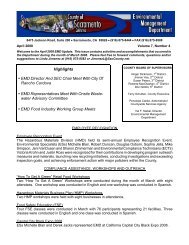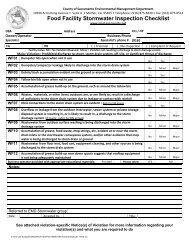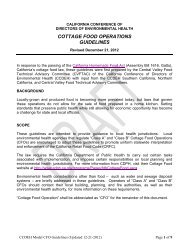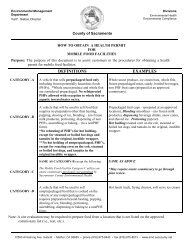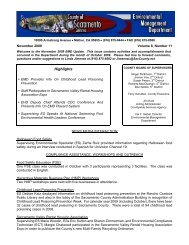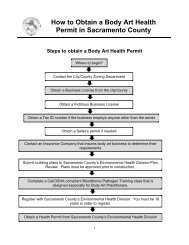The protective anodes <strong>of</strong> a cathodic protection well usually corrode away with time. Thus a cathodicprotection well's anodes determine the well's useful life. Anodes are usually designed tQ last 15 to 20 years.There has been an increasing tendency to construct cathodic protection wells with large diameter vent pipeor casing so that anodes can be replaced through the casing. Anode replacementhrough casing eliminatesthe need to drill replacement wells when anodes have been expended..Corrosion Coordinating CommitteesSerious electrical interference problems can occur where cathodic protection networks criss-cross one anotheror are too close to one another. Also, stray currents produced from.electrical transmission lines and otherequipment can sometimes interfere with the operation <strong>of</strong> cathodic protection systems. Interference problemsare usually most pronounced in urb;an areas.Corrosion control coordinating organizations have been formed in areas <strong>of</strong> <strong>California</strong> to overcome systeminterferences and other problems. Most organizations are affiliated with or are chapters <strong>of</strong> the NationalAssociation <strong>of</strong> Corrosion Engineers.Corrosion control organizations represent the majority <strong>of</strong> utilities and other groups that install cathodicprotection devices, including cathodic protection wells. Organization members coordinate the installation andoperation <strong>of</strong> cathodic protection facilities with the goal <strong>of</strong> minimizing problems <strong>of</strong> electrical interference.Four organizations that deal with Central and Southern <strong>California</strong>, are:.Southern<strong>California</strong>The Southern <strong>California</strong> Cathodic Protection Committee is a formal committee covering all <strong>of</strong> Southern<strong>California</strong> south <strong>of</strong> San Luis Obispo, Kern, and Inyo counties, except San Diego <strong>County</strong>..SanDiego <strong>County</strong>The San Diego <strong>County</strong> Underground Corrosion Control Committee is an informal organization that dealswith the San Diego area..Central<strong>California</strong>The Central <strong>California</strong> Cathodic Protection Committee is a formal committee covering all <strong>of</strong> Central<strong>California</strong> plus Sacramento Valley counties, and western Sierra Nevada mountain counties south <strong>of</strong> Plumas<strong>County</strong>..SanFrancisco Bay AreaThe activities <strong>of</strong> the two committees that formerly covered the San Francisco Bay Area have been assumedby the San Francisco Section <strong>of</strong> the National Association <strong>of</strong> Corrosion Engineers. The committees weredisbanded in 1985.No coordinating organizations function in coastal counties north <strong>of</strong> San Francisco or in the northeastern part<strong>of</strong> the State..Unfortunately, not all who install and operate cathodic protection facilities work with a corrosion coordinatingorganization. Those not associated with an organization are usually individuals or local agencies that aresometimes unaware <strong>of</strong> the existence <strong>of</strong> other installations. Non-coordinated facilities can seriously interferewith one another electrically.-62-
Need for Cathodic Protection <strong>Well</strong> <strong>Standards</strong>Cathodic protection wells, along with other types <strong>of</strong> wells, can allow ground water quality degradation to occur.Improperly constructed or destroyed cathodic protection wells can constitute a preferential pathway for themovement <strong>of</strong> poor-quality water, pollutants, and contaminants. Cathodic protection wells constructed withgravel backfill to land surface are particularly conducive to the movement <strong>of</strong> poor-quality water, pollutants,or contaminants.<strong>Water</strong> and electrolytes are sometimes introduced into cathodic protection wells through vent pipes, or gravelfill in the annulus, to keep wells functional where natural electrolytes are lacking. Such a practice could beconsidered "waste disposal" and may be illegal if poor-quality water is used.Permanently inactive cathodic protection wells pose a threat for the movement <strong>of</strong> poor-quality water,pollutants, and contaminants, and should be properly destroyed. Permanently inactive cathodic protectionwells are a threat to ground water quality because they become dilapidated with time, are sometimes forgotten,and are sometimes used for waste disposal.Many cathodic protection wells have small diameter vent pipes that prevent entry by persons and most animals.However, large vent pipe sizes can pose a serious safety threat if left open at land surface.History <strong>of</strong> Cathodic Protection <strong>Well</strong> <strong>Standards</strong>The <strong>California</strong> Legislature enacted legislation in 1949 directing the <strong>California</strong> Department <strong>of</strong> <strong>Water</strong> Resourcesto develop recommended water-quality protection standards for the construction and destruction <strong>of</strong> wells. TheLegislature amended the <strong>Water</strong> Code in 1968 to require standards for cathodic protection wells.Cathodic protection well standards for <strong>California</strong> were first published in 1973 as <strong>DWR</strong> <strong>Bulletin</strong> <strong>74</strong>-1, CathodicProtection <strong>Well</strong> <strong>Standards</strong>: State <strong>of</strong> <strong>California</strong>. <strong>Standards</strong> presented here replace those contained in <strong>Bulletin</strong><strong>74</strong>-1. Additional discussion on the history <strong>of</strong> well standards is contained in the "Introduction" section <strong>of</strong> thissupplement (<strong>Bulletin</strong> <strong>74</strong>-90) and <strong>Bulletin</strong> <strong>74</strong>-81, <strong>Water</strong> <strong>Well</strong> <strong>Standards</strong>: State <strong>of</strong> <strong>California</strong>.Scope <strong>of</strong> <strong>Standards</strong>The following are recommended minimum standards for construction, alteration, maintenance, and destruction<strong>of</strong> cathodic protection wells in <strong>California</strong>. They only serve as minimum guidelines toward ensuring cathodicprotection wells do not constitute a significant pathway for movement <strong>of</strong> poor-quality water, pollutants, andcontaminants. These standards do not ensure a cathodic protection well will perform its corrosion protectionfunction adequately.The functional requirements <strong>of</strong> cathodic protection wells may conflict with the application <strong>of</strong> certain standardsfor the protection <strong>of</strong> water quality. Consequently, some compromise has been made between well functionand resource protection in the development <strong>of</strong> these standards.Organization <strong>of</strong> <strong>Standards</strong>These standards are arranged in a format similar to the <strong>Water</strong> <strong>Well</strong> <strong>Standards</strong>. Since many <strong>of</strong> the standardsthat apply to water wells also apply to cathodic protection wells, many references are made in these standardsto the <strong>Water</strong> <strong>Well</strong> <strong>Standards</strong>. <strong>Standards</strong> that apply only to cathodic protection wells or that require emphasisfor cathodic protection wells, are discussed in detail in these standards.-63-



